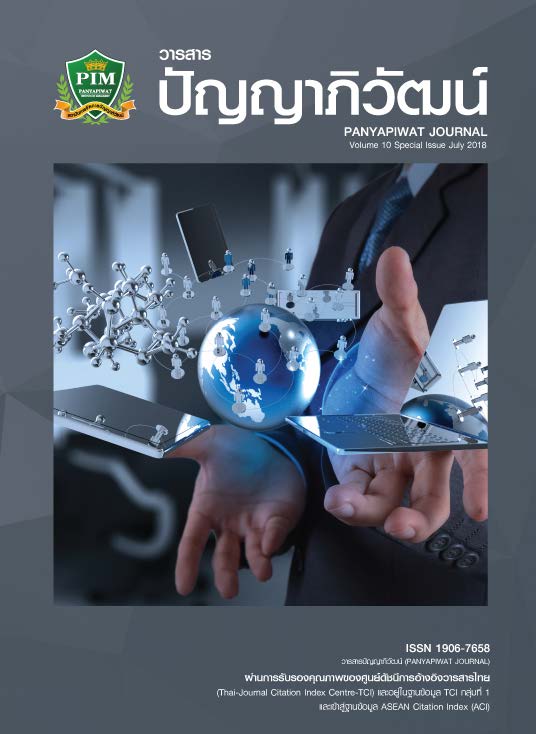การพัฒนารูปแบบการจัดการเรียนรู้แบบผสมผสานในวิชาการถ่ายภาพดิจิทัล
Main Article Content
บทคัดย่อ
การพัฒนารูปแบบการจัดการเรียนรู้แบบผสมผสานในวิชาการถ่ายภาพดิจิทัล เน้นการศึกษาการจัดการเรียนรู้แบบผสมผสานทั้งภาคทฤษฎี และภาคปฏิบัติ โดยมีการจัดการเรียนการสอนบนเว็บไซต์ (Web-Based Instruction) และการเรียนการสอนแบบดั้งเดิม (Face to Face Instruction) ซึ่งดำเนินการวางแผนและออกแบบการเรียนการสอนโดยคณะดิจิทัลมีเดียและศิลปะภาพยนตร์ มหาวิทยาลัยกรุงเทพ และบริษัท พิก โปรสคูล (PIXPROsCOOL) เป็นผู้จัดเตรียมระบบบนเว็บไซต์ การวิจัยในครั้งนี้มีวัตถุประสงค์หลักเพื่อทดลองใช้รูปแบบการจัดการเรียนรู้แบบผสมผสานในวิชาการถ่ายภาพดิจิทัล และศึกษาผลสัมฤทธิ์ทางด้านการเรียน และความพึงพอใจของนักศึกษาที่มีต่อรูปแบบการจัดการเรียนรู้แบบผสมผสานในวิชาการถ่ายภาพดิจิทัล งานวิจัยชิ้นนี้ใช้ระเบียบวิธีวิจัยแบบผสมผสาน โดยแบ่งเป็น 2 ส่วน ทางด้านการวิจัยเชิงคุณภาพใช้การศึกษาเอกสาร ศึกษากลุ่ม หรือบุคคลด้วยการสังเกต การสนทนากลุ่ม การสัมภาษณ์เชิงลึกจากผู้เชี่ยวชาญ ส่วนการวิจัยเชิงปริมาณนั้นใช้แบบสอบถามจากกลุ่มตัวอย่าง ซึ่งเป็นนักศึกษาวิชาการถ่ายภาพดิจิทัล ก่อนเรียนจำนวน 436 คน และหลังเรียนจำนวน 463 คน รูปแบบของการเรียนรู้ในรายวิชานี้ เป็นการผสมผสานการเรียนการสอนแบบดั้งเดิมที่มีการปฏิสัมพันธ์กันแบบเผชิญหน้า 30% และการเรียนบนเว็บไซต์ 70% ผลสัมฤทธิ์ก่อนการเรียนอยู่ในระดับน้อย (ค่าเฉลี่ย 2.43) ส่วนผลสัมฤทธิ์หลังการเรียนอยู่ในระดับมาก (ค่าเฉลี่ย 3.81) ความคาดหวังต่อการจัดการเรียนรู้อยู่ในระดับมาก (ค่าเฉลี่ย 4.00) และความพึงพอใจอยู่ในระดับมากเช่นกัน (ค่าเฉลี่ย 3.73) แต่ต่ำกว่าความคาดหวัง การเรียนรู้แบบผสมผสานในวิชาการถ่ายภาพดิจิทัลมีทั้งจุดเด่น และจุดด้อย ควรมีการพัฒนาทั้งด้านการจัดการเรียนการสอน เนื้อหา และผู้สอน
Article Details
“ข้าพเจ้าและผู้เขียนร่วม (ถ้ามี) ขอรับรองว่า บทความที่เสนอมานี้ยังไม่เคยได้รับการตีพิมพ์และไม่ได้อยู่ระหว่างกระบวนการพิจารณาลงตีพิมพ์ในวารสารหรือแหล่งเผยแพร่อื่นใด ข้าพเจ้าและผู้เขียนร่วมยอมรับหลักเกณฑ์การพิจารณาต้นฉบับ ทั้งยินยอมให้กองบรรณาธิการมีสิทธิ์พิจารณาและตรวจแก้ต้นฉบับได้ตามที่เห็นสมควร พร้อมนี้ขอมอบลิขสิทธิ์บทความที่ได้รับการตีพิมพ์ให้แก่สถาบันการจัดการปัญญาภิวัฒน์หากมีการฟ้องร้องเรื่องการละเมิดลิขสิทธิ์เกี่ยวกับภาพ กราฟ ข้อความส่วนใดส่วนหนึ่งและ/หรือข้อคิดเห็นที่ปรากฏในบทความข้าพเจ้าและผู้เขียนร่วมยินยอมรับผิดชอบแต่เพียงฝ่ายเดียว”
เอกสารอ้างอิง
Armstrong, J. & Franklin, T. (2008). A review of current and developing international practice in the use of social networking (Web 2.0) in higher education. Retrieved July 2, 2016, from https://www.franklin-consulting.co.uk
Ausburn, L. J. (2004). Design components most valued by adult learnners in blended online education environments: An Amerian perspective. Educational Media International, 41(4), 327-337.
Boyle, T., Bradley, C., Chalk, P., Jones, R. & Pickard, P. (2003). Using blended learning to improve student success rates in learning to program. Journal of Educational Media, 28(2-3), 165-178.
Clark, G. (1996). Glossary of CBT/WBT Terms. Retrieved July 2, 2016, from www.clark.net.pub
Collis, B. & Moonen, J. (2001). Flexible learning in a digital world: Experiences and expectations. London: Routledge.
Computer Institute, Ramkamhaeng University. (2009). Twitter. Retrieved August 20, 2016, from https://computer.ru.ac.th [in Thai]
Detchaisee, U. (2010). Teachers’ manual in learning management plan. Learning Group of Occupation and Technology. Bangkok: Wattanapanit Publishing. [in Thai]
Driscoll, J. (2002). The potential of reflective practice to develop individual orthopaedic nurse practitioners and their practice. Journal of Orthopaedic Nursing 5, 95-103.
Khan, B. H. (1997). Web-Based Instruction. Englewood Cliffs, NJ: Educational Technology Publications.
Malithong, K. (2005). Technology and Communication for Education. Bangkok: Aroon Printing. [in Thai]
Ministry of Education. (2002). The Act of National Education 1999 Revision (2nd ed.). Bangkok: The Teachers Council of Thailand. [in Thai]
Ministry of Education. (2008). Core Curriculum of Fundamental Education 2008. Bangkok: The Agricultural Co-operative Federation of Thailand. [in Thai]
Na Songkla, J. (1999). Innovation of learning management via worldwide network. Bangkok: Chulalongkorn University Printing. [in Thai]
Panit, W. (2012). How to Create Knowledge for Students in the 21st Century. Bangkok: Tatata Publishing. [in Thai]
Parson, R. (1997). An Investigation into Instruction available on the world wide. Retrieved July 18, 2016, from https://www.academia.edu/405017/An_Investigation_Into_Instruction_Available_on_World_Wide_Web_1997
Plaengsorn, B. (2008). Result of learning via simulation on web by blog in order to reflect learning which affects educational achievement and attitude about drug of the 2nd Year of secondary school students. Master of Education Thesis, Field of Audiovisual Education, Chulalongkorn University. [in Thai]
Relan, A. & Gillani, B. (1997). Web-based Instruction and the traditional classroom: similarities and difference. Retrieved May 25, 2016, form https://www.c3l.uni-oldenburg.de/cde/support/readings/relan97.pdf
Singpromma, W. (2013). Learning development of the subject of mixed media presentation through website and lecture for the 3rd year of high school students. In class research, Faculty of Education, Department of Vocational Education, Field of Business and Computer Studies, Kasetsart University. [in Thai]
Sungjaroon, S. (2007). Result of learning on website by blog which affects learning achievement and endurance of learning English of secondary school students. Master of Education Thesis, field of Audiovisual Education, Chulalongkorn University. [in Thai]
Uttaranun, S. (1989). Technique of learning management systematically in the field of administration.Bangkok: Chulalongkorn University. [in Thai]
Van Dam, N. (2003). The e-Learning Fieldbook. NY: McGraw Hill Company.


